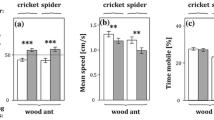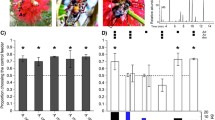Abstract
Prey-specialised predators have evolved specific cognitive adaptations that increase their prey searching efficiency. In particular, when the prey is social, selection probably favours the use of prey intraspecific chemical signals by predatory arthropods. Using a specialised ant-eating zodariid spider, Zodarion rubidum, which is known to prey on several ant species and possesses capture and venom adaptations more effective on Formicinae ants, we tested its ability to recognise chemical cues produced by several ant species. Using an olfactometer, we tested the response of Z. rubidum towards air with chemical cues from six different ant species: Camponotus ligniperda, Lasius platythorax and Formica rufibarbis (all Formicinae); and Messor structor, Myrmica scabrinodis and Tetramorium caespitum (all Myrmicinae). Z. rubidum was attracted to air carrying chemical cues only from F. rufibarbis and L. platythorax. Then, we identified that the spiders were attracted to airborne cues coming from the F. rufibarbis gaster and Dufour's gland, in particular. Finally, we found that among several synthetic blends, the decyl acetate and undecane mixture produced significant attraction of spiders. These chemicals are produced only by three Formicine genera. Furthermore, we investigated the role of these chemical cues in the communication of F. rufibarbis and found that this blend reduces their movement. This study demonstrates the chemical cognitive capacity of Z. rubidum to locate its ant prey using chemical signals produced by the ants. The innate capacity of Z. rubidum to olfactory detect different ant species is narrow, as it includes only two ant genera, confirming trophic specialisation at lower than subfamily level. The olfactory cue detected by Zodarion spiders is probably a component of the recruitment or trail pheromone.







Similar content being viewed by others
References
Allan RA, Elgar MA, Capon RJ (1996) Exploitation of an ant chemical alarm signal by the zodariid spider Habronestes bradleyi Walckenaer. P Roy Soc B-Biol Sci 263:69–73
Astruc C, Julien JF, Errard C, Lenoir A (2004) Phylogeny of ants (Formicidae) based on morphology and DNA sequence data. Mol Phylogenet Evol 31:880–893
Austin AD, Blest AD (1979) The biology of two Australian species of dinopid spider. J Zool 189:145–156
Bagnéres AG, Morgan ED, Clement JL (1991) Species-specific secretions of the Dufour glands of three species of Formicinae ants (Hymenoptera: Formicidae). Biochem Syst Ecol 19:25–33
Begström G, Löfqvist J (1968) Odour similarities between the slave-keeping ants Formica sanguinea and Polyergus rufescens and their slaves Formica rufa and Formica rufibarbis. J Insect Physiol 14:995–1011
Begström G, Löfqvist J (1970) Chemical basis for odour communication in four species of Lasius ants. J Insect Physiol 16:2353–2375
D'Ettorre P, Errard C, Ibarra F, Francke W, Hefetz A (2000) Sneak in or repel your enemy: Dufour's gland repellent as a strategy for successful usurpation in the slave-maker Polyergus rufescens. Chemoecology 10:135–142
Eberhard WG (1991) Chrosiothes tonala (Araneae: Theridiidae): a web-building spider specializing on termites. Psyche 98:7–19
El-Sayed AM (2011) The pherobase: database of insect pheromones and semiochemichals. http://www.pherobase.com. Accessed 14 December 2011
Feener DH, Jacobs LF, Schmidt JO (1996) Specialized parasitoid attracted to a pheromone of ants. Anim Behav 51:61–66
Graham RA, Brand JM, Markovetz AJ (1979) Decyl acetate syntesis in the ant: Formica schaufussi (Hymenoptera: Formicidae). Insect Biochem 9:331–333
Heller G (1974) Zur Biologie der ameisenfressen-den Spinne Callilepis nocturna Linnaeus 1758 (Araneae: Drassodidae). Johannes Gutenberg-Universität, Mainz
Hölldobler B, Wilson EO (1990) The ants. Springer, Berlin-Heidelberg
Jackson BD, Morgan ED (1993) Insect chemical communication: pheromones and exocrine glands of ants. Chemoecology 4:125–144
Jackson RR, Pollard SD (1996) Predatory behavior of jumping spiders. Annu Rev Entomol 41:287–308
Jackson RR, Whitehouse MEA (1986) The biology of New Zealand and Queensland pirate spiders (Araneae: Mimetidae): aggressive mimicry: araneophagy and prey specialization. J Zool 25:249–272
Longhurst C, Howse PE (1978) The use of kairomones by Megaponera foetens (Fab.) (Hymenoptera: Formicidae) in the detection of its termite prey. Anim Behav 26:1213–1218
Loxdale HD, Lushai G, Harvey JA (2011) The evolutionary improbability of “generalism” in nature, with special reference to insects. Biol J Linn Soc 103(1):1–18
Martišová M, Bilde T, Pekár S (2009) Sex-specific kleptoparasitic foraging in ant-eating spiders. Anim Behav 78:1115–1118
Mitrov MD (2011) Formicidae. Fauna Europaea. http://www.faunaeur.org/. Accessed 14 December 2011
Morrison LW, King JR (2004) Host location behavior in a parasitoid of imported fire ants. J Insect Behav 17:367–383
Parry K, Morgan ED (1979) Pheromones of ants: a review. Physiol Entomol 4:161–189
Pekár S (2004) Predatory behavior of two European ant-eating spiders (Araneae: Zodariidae). J Arachnol 32:31–41
Pekár S (2005) Predatory characteristics of ant-eating Zodarion spiders (Araneae: Zodariidae): potential biological control agents. Biol Control 34:196–203
Pekár S, Brabec M (2012) Modern analysis of biological data. 2. Linear models with correlation in R. Masaryk University Press, Brno
Pekár S, Hruškova M, Lubin Y (2005) Can solitary spiders (Araneae) cooperate in prey capture? J Anim Ecol 74:63–70
Pekár S, Toft S, Hruškova M, Mayntz D (2008) Dietary and prey-capture adaptations by which Zodarion germanicum: an ant-eating spider (Araneae: Zodariidae): specialises on the Formicinae. Naturwissenschaften 95:233–239
Pekár S, Bilde T, Martišova M (2011) Intersexual trophic niche partitioning in an ant-eating spider (Araneae: Zodariidae). PLoS One 6:e14603
Porter SD, Eastmond DA (1982) Euryopis coki (Theridiidae): a spider that prey on Pogonomyrmex ants. J Arachnol 10:275–277
Rantala MJ, Kortet R, Kotiaho JS, Vainikka A, Suhonen J (2003) Condition dependence of pheromones and immune function in the grain beetle Tenebrio monitor. Funct Ecol 17:534–540
Regnier FE, Wilson EO (1971) Chemical communication and "propaganda" in slave-maker ants. Science 172:267–269
Řezáč M, Pekár S (2007) Evidence for woodlice-specialization in Dysdera spiders: behavioural versus developmental approaches. Physiol Entomol 32:367–371
Royer L, Bolvin G (1999) Infochemicals mediating the foraging behaviour of Aleochara bilineata Gyllenhal adults: sources of attractants. Entomol Exp Appl 90:199–205
Schönrogge K, Napper EK, Birkett MA, Woodcock CM, Pickett JA, Wadhams LJ (2008) Host recognition by the specialist hoverfly Microdon mutabilis: a social parasite of the ant Formica lemani. J Chem Ecol 34:168–178
Sharma K, Vander Meer RK, Fadamiro HY (2011) Phorid fly, Pseudacteon tricuspis: response to alkylpyrazine analogs of a fire ant: Solenopsis invicta, alarm pheromone. J Insect Physiol 57:939–944
Steidle JL, van Loon JJA (2003) Dietary specialization and infochemical use in carnivorous arthropods: testing a concept. Entomol Exp Appl 108:133–148
Stowe MK, Turlings TCJ, Loughrin JH, Lewis WJ, Tumlinson JH (1995) The chemistry of eavesdropping, alarm, and deceit. PNAS 92:23–28
Thomas RS, Glen DM, Symondson WOC (2008) Prey detection through olfaction by the soil-dwelling larvae of the carabid predator Pterostichus melanarius. Soil Biol Biochem 40:207–216
Vander Meer RK, Breed MD, Winston ML, Espelie KE (1998) Pheromone communication in social insects: ants, wasps, bees and termites. Westview Press, Oxford
Witte V, Disney RHL, Weissflog A, Maschwitz U (2010) Studies in European ant-decapitating flies (Diptera: Phoridae): ant alarm pheromone as host finding cue in Pseudacteon brevicauda: a parasite of Myrmica rubra (Formicidae: Myrmicinae). J Nat Hist 45:905–912
Wyeth RC, Willows AOD (2006) Odours detected by rhinophores mediate orientation to flow in the nudibranch mollusc: Tritonia diomedea. J Exp Biol 209:1441–1453
Yeargan KV (1994) Biology of bolas spiders. Annu Rev Entomol 39:81–99
Acknowledgments
We want thank to two anonymous reviewers for useful comments on the manuscript.
Author information
Authors and Affiliations
Corresponding authors
Additional information
Communicated by: Sven Thatje
Rights and permissions
About this article
Cite this article
Cárdenas, M., Jiroš, P. & Pekár, S. Selective olfactory attention of a specialised predator to intraspecific chemical signals of its prey. Naturwissenschaften 99, 597–605 (2012). https://doi.org/10.1007/s00114-012-0938-9
Received:
Revised:
Accepted:
Published:
Issue Date:
DOI: https://doi.org/10.1007/s00114-012-0938-9




